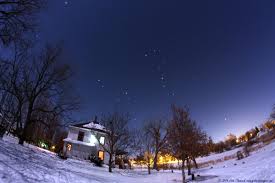How to Find the Little Dipper: 11 Steps

Introduction:
The Little Dipper, also known as Ursa Minor or the Little Bear, is a prominent constellation in the night sky. It’s not only an enchanting sight but also serves as a great navigational tool. In this article, we will take you through 11 steps to help you locate the Little Dipper with ease.
Step 1: Determine the best time to look for it
The Little Dipper is visible throughout the year in the northern hemisphere. In spring and summer, it’s at its highest point in the sky, making it easier to spot.
Step 2: Find a suitable location
Choose a dark place away from city lights and try to avoid any obstructions that might block your view of the horizon.
Step 3: Familiarize yourself with Ursa Minor
The Little Dipper consists of seven main stars that form a shape similar to a ladle or saucepan. Polaris (the North Star) is at the end of the handle while Kochab and Pherkad make up part of the ladle itself.
Step 4: Locate Ursa Major or the Big Dipper
Before you find the Little Dipper, it’s easier to locate its bigger neighbor – Ursa Major or the Big Dipper. This constellation also has seven main stars that create a more recognizable pattern.
Step 5: Use Ursa Major as a guide
Draw an imaginary line connecting the two outermost stars of the Big Dipper’s ladle (Dubhe and Merak). Extend this line towards the sky – it will directly point toward Polaris, our next step.
Step 6: Identify Polaris
Polaris is easily distinguishable as it’s one of the brightest stars in that region of the sky. As mentioned earlier, this star marks the end of Little Dipper’s handle.
Step 7: Trace the handle
Once you’ve recognized Polaris, try to trace the Little Dipper’s handle backward. It consists of 3 smaller stars named Yildun, Epsilon Ursae Minoris, and Zeta Ursae Minoris.
Step 8: Find Kochab and Pherkad
These two stars are a bit harder to find but are also part of Ursa Minor. Kochab is located below Polaris, while Pherkad lies right next to it. Together with Polaris, they form a stretched triangle.
Step 9: Complete the ladle
Continue tracing the three other stars in the ladle – Eta Ursae Minoris, Anwar al-Farkadain, and Akhfa al-Farkadain. Now you should be able to visualize the whole Little Dipper constellation.
Step 10: Enhance your experience
If you’re having trouble seeing some of the fainter stars with the naked eye, consider using binoculars or a telescope to get a clearer view.
Step 11: Keep practicing
Finding constellations is like learning any other skill – it takes practice. The more frequently you seek out the Little Dipper, the easier it will become to locate.
Conclusion:
There you have it – 11 steps to finding the enchanting Little Dipper! As we journey through life, this celestial companion will be a steadfast presence in our night sky. So, take a moment on your next stargazing adventure to appreciate its immense beauty and wonder.






